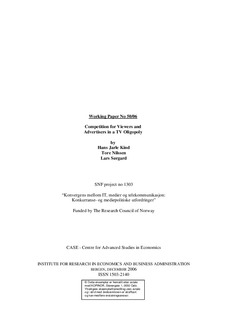| dc.contributor.author | Kind, Hans Jarle | |
| dc.contributor.author | Nilssen, Tore | |
| dc.contributor.author | Sørgard, Lars | |
| dc.date.accessioned | 2007-04-27T10:13:06Z | |
| dc.date.available | 2007-04-27T10:13:06Z | |
| dc.date.issued | 2006-12 | |
| dc.identifier.issn | 1503-2140 | |
| dc.identifier.uri | http://hdl.handle.net/11250/166082 | |
| dc.description.abstract | We consider a model of a TV oligopoly where TV channels transmit advertising and viewers dislike such commercials. We show that advertisers make a lower profit the larger the number of TV channels. If TV channels are sufficiently close substitutes, there will be underprovision of advertising relative to social optimum. We also find that the more viewers dislike ads, the more likely it is that welfare is increasing in the number of advertising financed TV channels. A publicly owned TV channel can partly correct market distortions, in some cases by having a larger amount of advertising than private TV channels. It may even have advertising in cases where advertising is wasteful per se. | en |
| dc.language.iso | eng | en |
| dc.publisher | SNF | en |
| dc.relation.ispartofseries | Working paper | en |
| dc.relation.ispartofseries | 2006:50 | en |
| dc.subject | television industry | en |
| dc.subject | advertising | en |
| dc.title | Competition for viewers and advertisers in a tv oligopoly | en |
| dc.type | Working paper | en |
| dc.subject.nsi | VDP::Samfunnsvitenskap: 200::Medievitenskap og journalistikk: 310 | en |
